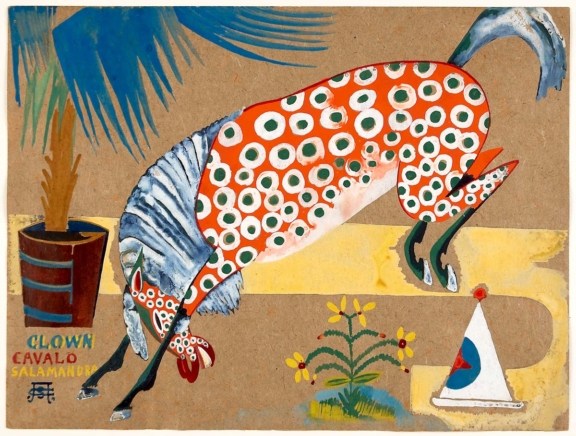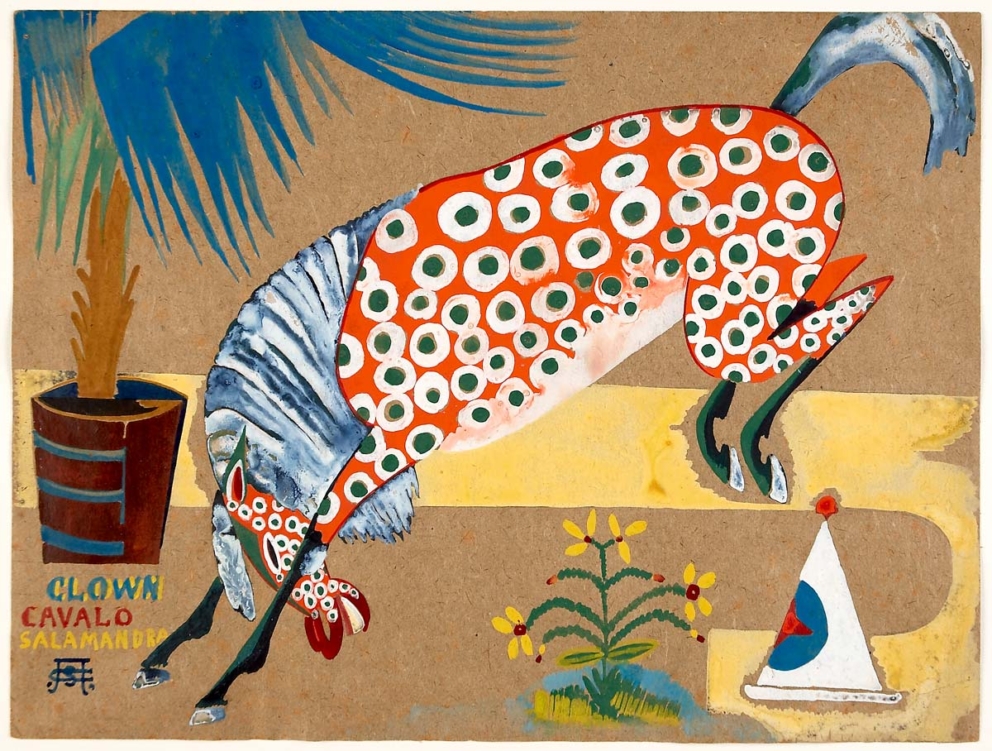
- 1911
- Gouache on paper
- Inv. 77DP345
Amadeo de Souza-Cardoso
Title unknown (Clown, Horse, Salamandra)
Clown, Cavalo, Salamandra [Clown, Horse, Salamander] is the most frequently reproduced of Amadeo’s gouaches and was probably featured in his first exhibition with Modigliani (1911).[1] Although his work at the time was dominated by drawing, this brief foray into gouache would prove decisive, leading him to the pictorial experiments that he would later undertake in oil, imbuing the graphic simplicity of his compositions with the bright colours and intense materiality that became his trademarks and exploring new ways of representing rhythm and movement in his usual hunting themes.
Two identical preparatory drawings of this gouache (see I and II) are known to exist, in which the appearance of the horse appears to be copied from a Japanese parchment by Fujiwara Takanobu (12th century).[2] However, the figure of the mounted horseman disappears from the gouache and is replaced by an unlikely colourful clown’s hat. Despite not being decorated in the drawing, the horse, the work’s sole character, acquires the extravagant pigmentation of a salamander in the form of white and green circles (exaggerating the spotted horse of the Japanese icon) amid a hotchpotch of pictorial signs. In the year in which Franz Marc began to paint blue horses and before the Robert Delaunay had invented the orphic circle, these spots became a recurring motif in Amadeo’s work, which he manipulated variedly as a strategy to reconsider the ideas of representation that were most attacked by the avant-gardes: the rhythm, space and vitality.
Unlike the exotic Douanier Rousseau-style jungle seen in the drawing, with its schematic, minimal framing of plants in the foreground and a palm tree in the background, the palm tree in the gouache is placed in a flower bed. The scene depicted seems to be situated in an (unfinished?) interior traversed by a yellow patch that unites the various parts of the image, which are characterised by flat space and varying scales. Since the inscription Clown, Horse, Salamander is not known to have any putative narrative referent, the apparently random combination of words appears to herald the futurist use of this device that he would subsequently employ. However, the uncanny illustration evokes the festive atmosphere characteristic of the programme of visual euphoria pursued by Amadeo, which took the circus as a central motif of modern art and popular culture (bearing coincident parallels with Seurat’s famous work[3]) in order to explore, in a visually appealing manner, the pictorial possibilities offered by lively colours and drawing.
Afonso Ramos
June 2013
[1] The exhibition of Amadeo and Modigliani’s work took place in the Portuguese artist’s studio at no. 3 rue Colonel Combes, in Paris. According to the artist, he presented ‘drawings and a few works on cardboard’ along with gouaches and seven sculptures by Modigliani. The guests of honour included Apollinaire, Brancusi, Derain, Max Jacob and Picasso.
[2] The original, Handscroll of Horses, is in the British Museum, London. Cf. Amadeo de Souza Cardoso: diálogo de vanguarda, Lisbon: CAM/FCG, 2006, p. 187.
[3] Seurat’s emblematic work Le Cirque (1890), whose palette is partially echoed here, appears to have been directly cited by Amadeo in a drawing produced in the same year.
| Type | Value | Unit | Section |
| Width | 31,8 | cm | |
| Height | 23,8 | cm |
| Type | title |
| Type | signed |
| Text | A.S.C. |
| Position | bottom left-hand corner |
| Type | Donation |
| Date | 1977 |
| Amadeo de Souza-Cardoso: peintre portugais, 1887-1918/ Amadeo de Souza Cardoso: portuguese painter, 1887-1918 |
| Paris, Centre Culturel Calouste Gulbenkian, 1995 |
| Monograph |
| 1887-1987 centenário do nascimento de amadeo de souza-cardoso/ 1887-1987 birth centenary of amadeo de souza-cardoso |
| Lisbon, Fundação Calouste Gulbenkian, 1987 |
| Catalogue |
| Amadeo de Souza-Cardoso: diálogo de vanguardas/ Amadeo de Souza-Cardoso: avant-garde dialogues |
| Lisbon, Fundação Calouste Gulbenkian. Centro de Arte Moderna José de Perdigão, Assírio & Alvim, 2006 |
| Catalogue |
| Amadeo de Souza-Cardoso (1887-1918): Ein pionier aus Portugal/ Amadeo de Souza-Cardoso (1887-1918): A pioneer from Portugal |
| Hamburg, Ernst Barlach Haus, 2007 |
| Catalogue |
| 1887-1987 centenário do nascimento de amadeo de souza- cardoso/ 1887-1987 birth centenary of amadeo de souza-cardoso |
| Calouste Gulbenkian Foundation |
| Curator: Calouste Gulbenkian Foundation |
| 20 July 1987 to 31 October 1987 Calouste Gulbenkian Foundation |
| Amadeo de Souza-Cardoso: diálogo de vanguardas/ Amadeo de Souza-Cardoso: avant-garde dialogues |
| Curator: FREITAS, Helena de |
| 15 November 2006 to 15 January 2007 Calouste Gulbenkian Foundation |
| Amadeo de Souza-Cardoso (1887-1918): Ein pionier aus Portugal/ Amadeo de Souza-Cardoso (1887-1918): A pioneer from Portugal |
| 2 December 2007 to 30 March 2008 Ernst Barlach Haus |
